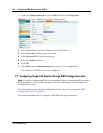
Configuring KIRK Wireless Server 600v3 117
KIRK Wireless Server 600v3 Installation and Configuration Guide
7.6.5 Configuring Secondary KWS600v3 Using a Back-Up File
A previously saved configuration file can be loaded to the KWS600v3 and used as input
for configuration.
Note: For more information about configuring the first Secondary KWS600v3 to be used
as input in the configuration of more KWS600v3 secondaries, refer to
“” on page 108. For
more information about making a backup of a configuration file, refer to “Updating
Configuration File” on page 178.
1 Upload the configuration file to the KWS600v3 secondary in question.
For more information about updating the configuration file, refer to “Updating
Configuration File” on page 178.
2 Change the IP address.
For more information about changing the IP address, refer to “Assigning a Specific IP
Address (Secondary)” on page 111.
3 Change radio ID.
For more information about changing the radio ID, refer to “Configuring DECT
Radio (Secondary)” on page 116.
4 Change Primary Sync ID.
For more information about changing the Primary Sync ID, refer to “Configuring DECT
Radio (Secondary)” on page 116.
5 Change alternative Sync ID.
For more information about changing the alternative Sync ID, refer to “Configuring
DECT Radio (Secondary)” on page 116.
6 Click Reset to save your configuration.
7.6.6 Configuring Standalone LDAP Server
In a KWS600v3 Multi-cell solution it is possible to configure an LDAP Server to handle all
handset/user registration data (such as name, directory number, IPEI etc.).
If you configure an LDAP Server to handle all handset/user registration and read/write
information between the primaries and secondaries of a KWS600v3 Solution, then the
Master KWS600v3 only manage the connection to the call handler.
Note: Configuring an LDAP Server is only recommended in very large multi-cell
installations (more than 500-600 handsets).


















